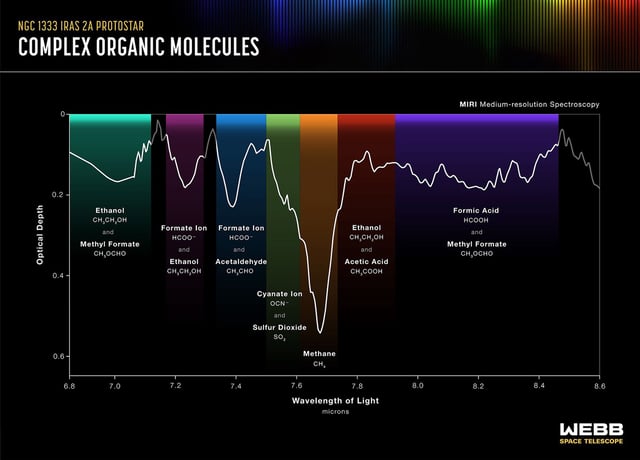Overview
- The James Webb Space Telescope has detected complex organic molecules such as ethanol and acetic acid around two protostars, suggesting the presence of key ingredients for potentially habitable worlds.
- These molecules were found in icy compounds surrounding the protostars IRAS 2A and IRAS 23385, indicating that such complex organic molecules may originate from the sublimation of ices.
- The discovery could provide insights into the chemical complexity developed in star-forming regions and the potential habitability of future exoplanetary systems.
- The presence of these molecules in space supports the theory that the building blocks of life could be more common across the cosmos than previously thought.
- Astronomers plan to follow this astrochemical trail with more Webb data in the coming years, potentially uncovering further details about the origins of complex organic molecules in space.
![This image was taken by Webbâs Mid-InfraRed Instrument (MIRI) of a region parallel to the massive protostar known as IRAS23385. IRAS 2A and IRAS23385 (not visible in this image) were targets for a recent research effort by an international team of astronomers that used Webb to discover that the key ingredients for making potentially habitable worlds are present in early-stage protostars, where planets have not yet formed. With MIRIâs unprecedented spectral resolution and sensitivity, the JOYS+ (James Webb Observations of Young ProtoStars) programme individually identified organic molecules that have been confirmed to be present in interstellar ices. This includes the robust detection of acetaldehyde, ethanol, methyl formate, and likely acetic acid, in the solid phase. [Image description: A region of a molecular cloud. The cloud is dense and bright close to the top of the image, like rolling clouds, and grows darker and more wispy towards the bottom and in the top corner. One bright star, and several dimmer stars, are visible as light spots among the clouds. The image is a single exposure which has been assigned an orange colour for visibility.]](/cdn-cgi/image/onerror=redirect,width=640,height=640,format=webp/https://storage.googleapis.com/uploads.mongoosehq.com/url/media/7613696/d64926b0d63b6108b388a15f18ca19a84191327a06a4c51e43256f120aba2c6b)

